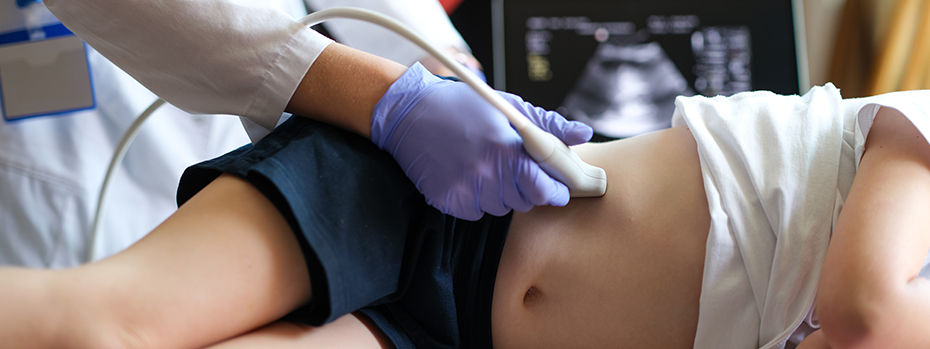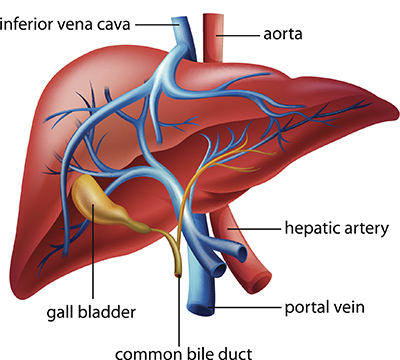Pediatric Liver Diseases

Find treatment for children with liver disorders or hepatitis
Learn about high-quality liver disease and hepatology treatment for your child at OHSU Doernbecher Children’s Hospital.
Our liver care team includes Henry Lin, M.D., Oregon’s only board-certified pediatric hepatologist. We offer leading-edge liver disease diagnosis and treatment for children, from newborns to young adults. Your family will find:
- State-of-the art testing to diagnose your child’s symptoms.
- Doctors working together to provide advanced medical, surgical and nutritional options.
- Specialized hepatology care as part of Doernbecher’s Single Ventricle Program.
- Programs to help kids with anxiety, sleep and nutrition.
- Support for physical, mental and social impacts on your child.
Understanding liver diseases in children
What is pediatric liver disease?
Liver diseases in children include a range of conditions with different causes and symptoms. These disorders can happen when the bile ducts, portal vein or hepatic artery are not working right. There are many reasons the liver stops working well, and it is also impacted by other parts of the digestive system. All pediatric liver disorders require specialty care.
How the liver works
The liver is part of the digestive system and the largest organ in the body. Along with removing toxins from the blood, the liver also helps with digestion, metabolism and keeping the body safe from infection.
Sections of the liver are called lobes. Inside the liver are bile ducts, the portal vein and the hepatic artery.
- Bile ducts are tubes that carry bile out of your liver. The liver makes bile (a yellow fluid) to help the body break down and absorb fats.
- The portal vein carries blood to the liver from the intestines. It supplies the liver with 80% of the blood it needs.
- The hepatic artery supplies the remaining 20% of the blood your liver needs. The hepatic artery carries blood to the liver from the heart.

Who gets pediatric liver diseases?
Each year in the U.S., 1 in 2,500 babies is born with a liver disease. 15,000 children are hospitalized with liver-related conditions each year. Children of any age, sex and race can develop liver diseases.
What causes pediatric liver diseases?
Liver diseases have many causes, including:
- Genetics or hereditary factors. Some babies have genes that cause liver disease.
- Autoimmune problems (autoimmune means the body mistakenly attacks itself).
- Infections, usually caused by viruses.
- An injury to the liver.
- Exposure to toxins, like accidentally ingesting a poisonous chemical or taking too much medication (like Tylenol) at once.
Pediatric liver diseases are usually not caused by lifestyle factors, like alcohol use or unhealthy diets.
Symptoms of liver diseases
Signs of liver diseases can show up slowly over time or appear suddenly. If your child has any of these symptoms, take them to their pediatrician:
- Jaundice (yellowing of the skin and eyes)
- Itching, especially on the hands and feet and at night
- Abdominal pain and/or swelling
- Trouble sleeping or feeling very tired during the day
- Nausea and vomiting
- Grey or pale stool
- Loss of appetite
- Losing weight or not gaining weight
Some liver disease symptoms need immediate medical attention. If your child has any of the following symptoms, call 911 or take them to the emergency room:
- Black, tarry stool
- Severe abdominal pain
- Vomiting blood (sometimes this looks like coffee grounds)
Diagnosing pediatric liver diseases
If your child has symptoms that could be a liver disease, tests will help find the cause. These tests include:
Blood tests
We use a variety of blood tests to diagnose and treat pediatric liver diseases.
-
Results from a simple blood draw, called a liver panel, show if your child’s liver is irritated.
Liver biopsy
A physician will take a very small piece of your child’s liver so doctors can see it under a microscope. For this test, your child will be asleep and will not feel pain.
Imaging and scans
We have many tools to help us look closely at your child’s liver. Depending on which we use, your child may need to stop eating or drinking a few hours before the test. For some tests, they will drink a special liquid called contrast to help us see the liver better. Our imaging tools include:
- X-ray
- CT scan (computerized tomography)
- MRCP (magnetic resonance cholangiopancreatography)
- MRI (magnetic resonance imaging)
- Ultrasound
- HIDA scan (hepatobiliary iminodiacetic acid)
- Cholangiogram (an X-ray for the bile ducts)
ERCP (endoscopic retrograde cholangiopancreatography)
We place a camera on a long and flexible tube into your child's throat. This lets us see their digestive system from the inside. Your child will be asleep during ERCP and will not feel pain. They will need to stop eating or drinking a few hours before the test.
Treatment for pediatric liver diseases
Childhood liver diseases require specialty care. Some disorders are hard to treat, and often the best treatment is to manage symptoms.
At Doernbecher, we offer leading-edge liver care for kids, including advanced surgical and medical options. Experts in these specialties work together to care for your child:
- Gastroenterology
- Hepatology
- Psychology
- Nutrition
- Social work
Our team provides treatment for genetic, metabolic, autoimmune and neonatal liver conditions, including:
Acute liver failure
Acute liver failure is sudden and severe. It happens when a child is exposed to a toxin that harms the liver. Viral hepatitis is a common cause of acute liver failure. Overdosing on drugs, including over-the-counter medicines like Tylenol, can also cause acute liver failure.
Alagille Syndrome
In Alagille Syndrome, babies are born without enough bile ducts to remove bile (or waste) from the liver. This causes bile to build up in the liver, which leads to liver damage.
Alpha-1 antitrypsin deficiency
This disease is caused by a genetic mutation that means the body does not produce enough of an important enzyme. This leads to abdominal swelling and jaundice.
Autoimmune hepatitis
In this chronic liver disease, the body’s immune system attacks its liver cells, causing serious damage to the liver over time.
Benign liver tumors and cysts
Benign tumors and cysts are non-cancerous masses on the liver. Some babies are born with tumors or cysts, or they can appear later. A surgeon can remove big or bothersome masses. Rarely, tumors are malignant, or cancerous. In these cases, we refer children to Doernbecher’s pediatric cancer specialists.
Biliary atresia
Biliary atresia is a congenital disease, which means babies are born with it. It is a blockage in the tubes (bile ducts) that carry bile away from the liver.
Cystic fibrosis associated liver disease
When a child has cystic fibrosis, in some cases it can cause blockage in the liver’s small ducts, leading to liver disease.
Fontan-associated liver disease
Fontan-associated liver disease can happen when the liver is damaged during a procedure to repair the heart.
Gestational alloimmune liver disease (GALD)
GALD is a congenital disease, which means babies are born with it. Cells in the baby's liver don’t respond correctly to protective proteins (antibodies) in the mother's blood. GALD can lead to severe liver damage or liver failure.
Jaundice (hyperbilirubinemia)
Many babies are born with jaundice. It happens when bilirubin (a yellow pigment the body makes) moves through the body too slowly. Jaundice usually goes away on its own within a few weeks. But jaundice is also a symptom of other liver problems. If it does not go away, it is important to find out why.
Liver transplant
If your child has liver failure, then they may need a liver transplant. Our team collaborates with Stanford Medicine Children’s Hospital and Seattle Children's Hospital to support patients through liver transplants and recovery.
Metabolic dysfunction-associated steatotic liver disease (MASLD)
MALSD, formerly called non-alcoholic fatty liver disease (NAFLD), comes from a build of up fat in the liver. Conditions that affect your child’s metabolism, like type 2 diabetes and obesity, could cause MASLD.
Metabolic liver diseases
Metabolic liver diseases can happen when your child’s liver can’t metabolize, or process, nutrients.
Neonatal cholestasis
This condition occurs in newborns when there is a problem with bile flow and build-up in the liver.
Primary sclerosing cholangitis (PSC)
In PSC, bile ducts are so inflamed and scarred that they can’t carry bile (waste) away from the liver. Over time, PSC causes the bile ducts to be completely blocked and can lead to liver failure. Doctors are not sure what causes PSC, but many people who have it also have inflammatory bowel disease (IBD).
Progressive familial intrahepatic cholestasis (PFIC)
PFIC is caused by a genetic mutation. Bile can’t drain from the liver and toxins build up, leading to liver failure.
Viral hepatitis
Viral hepatitis is an infectious disease that inflames and harms the liver. The three common types are hepatitis A, B, and C, and each spreads differently.
Wilson Disease
This rare genetic disorder stops the body from getting rid of copper. This leads to excess copper in the liver and brain, which can cause liver and neurological damage.
Meet our team
Your child will receive care from our experts with special training in pediatric liver disease.
-
- Henry Lin, M.D., M.B.A.
- Accepting new patients
-
- Christina Low Kapalu, Ph.D. (she/her)
- Accepting new patients
-
- Jacklyn Stellway, Psy.D.
- Accepting new patients
- Ansley Hill, RD, LD, pediatric dietitian
- Christiana Logan, pediatric dietitian
- Kayla Miller, social worker
Resources for pediatric liver disease
- American Liver Foundation
- Children's Liver Disease Foundation: a nutrition guide for children with liver disease
- The Childhood Liver Disease Research Network (ChiLDReN)
Research and clinical trials
Our team takes part in research and clinical trials for pediatric liver disease therapies. Work with your child’s GI specialist to learn about promising new treatments and medications.
For families
Call 503-494-1078 to:
- Make an appointment
- Get a second opinion
- Ask a question
Locations
Parking is free for patients and their visitors.
Doernbecher Children’s Hospital
700 S.W. Campus Drive
Portland, OR 97239
Map and directions
Find other locations across Oregon and in southwest Washington.
For providers
- Refer a patient to Doernbecher.
- Call for provider advice: 503-346-0644
- Fax patient records and lab work: 503-418-1377
Medical treatment guides
- Constipation
- Functional abdominal pain
- Fatty liver (NAFLD)
- Work-up needs before your patient visits us
- Colonoscopy prep for your patients